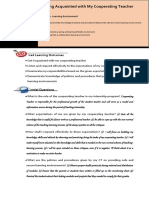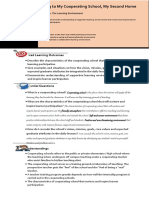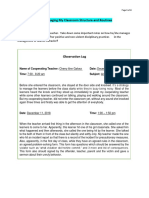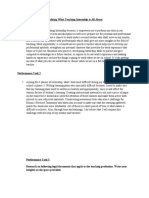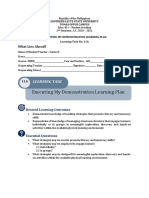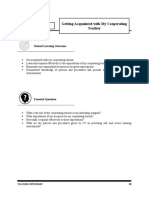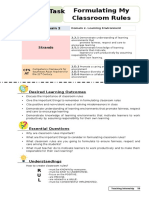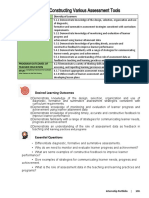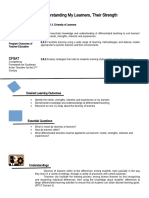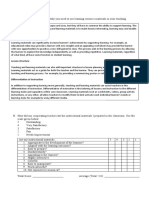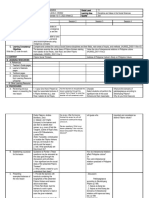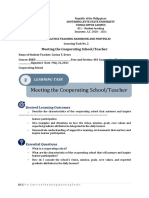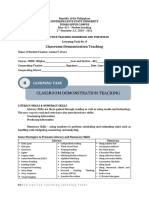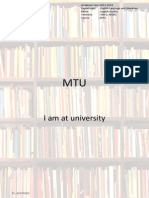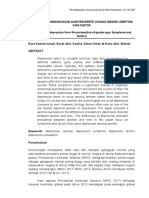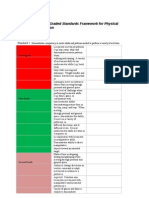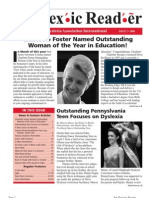Learning-Task-7 ROLAND P. PLATERO
Learning-Task-7 ROLAND P. PLATERO
Uploaded by
Platero RolandCopyright:
Available Formats
Learning-Task-7 ROLAND P. PLATERO
Learning-Task-7 ROLAND P. PLATERO
Uploaded by
Platero RolandCopyright
Available Formats
Share this document
Did you find this document useful?
Is this content inappropriate?
Copyright:
Available Formats
Learning-Task-7 ROLAND P. PLATERO
Learning-Task-7 ROLAND P. PLATERO
Uploaded by
Platero RolandCopyright:
Available Formats
Republic of the Philippines
SOUTHERN LEYTE STATE UNIVERSITY
TOMAS OPPUS CAMPUS
Educ 421 – Student teaching
2nd Semester, A.Y. 2020 – 2021
MY PRACTICE TEACHING HANDBOOK AND PORTFOLIO
Learning Task No. 7
On Teaching Strategies
Name of Student Teacher: ROLAND P. PLATERO
Course: BSED- FILIPINO Year and Section: 401
Cooperating Teacher _____________________________ Signature ______________________ Date ________________
Cooperating School _______________________________________________________________________________________
7 LEARNING TASK
ON TEACHING STRATEGIES
INTEGRATIVE LEARNING
Integrative learning helps the students make connections and relevance between and
among subjects. It allows the learners to engage in purposeful, relevant learning. It encourages
the learners to see the interconnectedness and interrelationships between the curriculum areas
rather than focusing in isolated curriculum areas.
According to Pigdon and Woolley (1992) in an integrated curriculum, all activities
contain opportunities for learners to learn more about content through purposeful activities.
HIGHER-ORDER THINKING SKILLS
Higher order thinking skills known also as HOTS imply that some types of learning
require higher cognitive processes than others. Skills in analyzing, evaluating, and creating are
thoughts of higher order than learning facts or concepts.
Source: https://cft.vanderbilt.edu/guides-sub-pages/blooms-taxonomy/
0|Pre-Service Teaching learning Tasks
VERBAL AND NON-VERBAL COMMUNICATION
Verbal communication is the use of words in expressing one’s feelings and ideas.
Non-verbal communication includes the use of body language, gesture, facial
expressions, eye contact, and posture.
The use of verbal and non-verbal communication strategies is the first step in enhancing
communication and nurturing relationships which are vital in the teaching-learning process.
Strong communication skills are very important in the instructional process.
My Performance Tasks
PERFORMANCE TASK 1: Get the topic you are assigned to teach. Write down how you can
apply the content knowledge within or across curriculum and teaching areas. Use the
curriculum web to indicate your proposed integration. Indicate the subjects in the circles and
how you will do it.
Make and interpret
the graph of price
elasticity and demand
using their papers
Appreciate the
concept of price Differentiate an
elasticity of inelastic product
demand in the and elastic product
Philippine economy
Price
Elasticity of
Demand
Let the students
Let the students explain each graph.
present and compare Follow up and
their answers. elaborate the answers
of students.
Ask the students what
they have learned from
activities today. What is
the important in
understanding elasticity
of demand?
1|Pre-Service Teaching learning Tasks
PERFORMANCE TASK 2: Write higher-order thinking questions that you used in the discussion
of the content.
Content/ Topic Questions
Philippine History 1) In your own words, who’s exactly the
first president of the Philippines?
Aguinaldo or Bonifacio? And why?
2) What are the advantages and
disadvantages of Spaniard
colonization?
3) What changes would you make to
revise the history of who’s first
president of the Philippines?
4) If you are in the self of Bonifacio,
what is your strategy to maintain of
being leader of KKK and in the
Philippines?
5) What facts can you gather in reading
the history of the Philippines?
Panitikan ng Rehiyon sa Pilipinas
1) Paano mo mapapanatili ang pagiging
buhay sa ala-ala ng mga tao ang ating
sariling panitikan o literatura?
2) Gumawa ng isang tula gamit ang
sariling karanasan sa buhay na may
tugma at sukat
3) Bilang isang mag-aaral, paano ka
makakatulong para muling
patingkarin ang mga panitikang
nakalimutan na sa paglipas ng
panahon?
English Literature
The Wedding Dance by Amador Daguio 1) What is the moral lesson of the story?
2) How will this lesson benefit you as a
person in the future?
3) If you are given a chance to end the
story in different way, what would it
be? And why?
4) If you are in the self of Lumnay would
you give a chance to Awiyao to return
into your life? And why?
5) In your own word, summarize the
story of “The Wedding Dance” in your
own understanding.
2|Pre-Service Teaching learning Tasks
PERFORMANCE TASK 3: Enumerate the non-verbal cues you used to support learner’s
participation and engagement.
Non-verbal Cues Purpose(s)
1. Body Language Gestures can transfer the student’s attitudes
and feelings to others and the actions in
many cases can be even more effective than
verbal messages. Body movements can be
used to reinforce or emphasise what a person
is saying and also offer information about the
emotions and attitudes of a person. However,
it is also possible for body movements to
conflict with what is said.
2. Facial Expressions Smiling - A smile generally indicates
happiness or contentment.
Scowling - A scowl or frown indicates
discontentment or frustration.
Lack of Expression - An
expressionless face can indicate, at a
minimum, two things. First, this can
be an indication or disinterest or
boredom. Second, and perhaps worse,
an expressionless face can indicate
disdain.
3. Proxemics Move around the room. Doing so helps keep
students’ focused and will give you an
opportunity to make more direct eye contact
with every student, not just those in the front
of the room.
https://www.skillsyouneed.com/ips/body-language.html
https://examples.yourdictionary.com/examples-of-non-verbal-communication.html
3|Pre-Service Teaching learning Tasks
PERFORMANCE TASK 4: Cite the verbal communication strategies that you need in class to
support learner’s understanding, participation, and engagement.
Cite how it supported the
Verbal Communication Strategies Used
learners in instruction
The better your communication skills, the
more effectively you can perform these tasks.
In turn, your students will make more
academic progress. Studies have found that
the success of students is directly related to
interactive, engaging teaching environments
Communicating with Students formed by able teachers. (Mashburn et al.,
2008).
The way that you communicate with your
students can positively affect their
perceptions of school, their role in the
classroom, themselves and their abilities, and
their motivation to succeed (Dobbs &
Arnold, 2009).
You can also use positive feedback to modify
students’ behaviour: for example, praising a
student for having their hand up is likely to
cause the students around them to stop
‘shouting out’ and copy this behaviour, in
order to be praised themselves (Howell,
Caldarella, Korth, & Young, 2014).
Feedback
Phrases such as ‘good job’ or ‘beautiful’ may
not motivate students, because they do not
understand what they are specifically being
praised for, while over-praising can cause
children to lack interest in situations where
they are not being praised (e.g. Howell et al.,
2014). As a result, you should give specific,
deserved positive feedback – use the
student’s name, explicitly state what they are
doing right, and thank them enthusiastically.
Create a safe and supportive environment
where students feel comfortable to open up
and express their thoughts and ideas. An
atmosphere that allows students to ask if
they need help is crucial to their academic
success. It is important that at all stages of
the teaching process that you nurture this
Create a safe environment kind of non-judgemental environment. By
having an open door policy and allowing
4|Pre-Service Teaching learning Tasks
students to pop in and talk about anything
that may occur is a great way to promote
good communication. Giving students extra
support, tuition or explanations before and
after class helps shy students that don’t feel
comfortable in class to ask questions to learn.
(Olivia Hanifan, 2019)
https://www.highspeedtraining.co.uk/hub/communication-skills-for-teachers/
https://www.mentimeter.com/blog/interactive-classrooms/5-ways-to-establish-effective-
communication-in-the-classroom
My Learning Artifacts
My Scoring Rubric
Meets Approaching Meets Does Not Meet
INDICATORS Standard of Standard of Acceptable Acceptable
Excellence Excellence Standards Standard
CRITERIA 4 3 2 1
Performance has all the has some aspects has minimal no aspect of work
Tasks aspects of work of work that aspects of work meets level of
that exceed level exceed level of that meet level of expectation.
5|Pre-Service Teaching learning Tasks
of expectation expectation. expectation. has errors,
Shows Demonstrates with some errors omissions, and
exemplary solid and MASTERY is misconceptions
performance performance and not thorough
understanding
Assessment With 5 correct With 4 correct With 3 correct With less than 3
Tasks answers answers answers correct answers
Learning The piece/s of The piece/s of The piece/s of The piece/s of
Artifacts evidence of evidence of evidence of evidence of
learning is/ are learning is/ are learning is/ are learning is/ are
aligned with aligned with SOME aligned with ONE NOT aligned with
learning of the learning of the learning the learning
outcomes. outcomes. outcomes. outcomes.
Creativity and The learning tasks The learning tasks The learning tasks The learning tasks
Resourcefulness are done very are done are done quite are poorly done
creatively and creatively and creatively and and need
resourcefully. resourcefully. resourcefully. improvement.
Submission of The assigned The assigned The assigned The assigned
Requirements learning tasks are learning tasks are learning tasks are learning tasks are
submitted on or submitted on a submitted 2 days submitted 3 days
before the day after the after the deadline. or more after the
deadline. deadline. deadline.
MY TOTAL SCORE
________________________________________
Signature of Practicum Supervisor
6|Pre-Service Teaching learning Tasks
You might also like
- Teaching Intership Learning Task 4Document7 pagesTeaching Intership Learning Task 4Hanily Asaytuno96% (25)
- Teaching Internship Learning Task 2Document8 pagesTeaching Internship Learning Task 2Hanily Asaytuno88% (49)
- Therapy WorksheetDocument47 pagesTherapy Worksheettyceiuk100% (2)
- Seeking Advice From MY CT To Enrich My Teaching Practice: Desired Learning OutcomesDocument5 pagesSeeking Advice From MY CT To Enrich My Teaching Practice: Desired Learning OutcomesJoan May de Lumen81% (31)
- Creating Instructional Materials Learning TaskDocument10 pagesCreating Instructional Materials Learning TaskKristine Joyce Nodalo100% (2)
- Teaching Intership Learning Task 5Document8 pagesTeaching Intership Learning Task 5Hanily Asaytuno80% (30)
- Teaching Intership Learning Task 5Document7 pagesTeaching Intership Learning Task 5Hanily Asaytuno100% (2)
- Learning Task 15: Constructing Various Assessment ToolsDocument7 pagesLearning Task 15: Constructing Various Assessment ToolsJe-In Allysie50% (4)
- Teaching Internship Learning Task 1Document5 pagesTeaching Internship Learning Task 1Hanily Asaytuno96% (23)
- Learning Task 3 Carina EveroDocument14 pagesLearning Task 3 Carina EveroPlatero Roland71% (7)
- Learning Task 3 Carina EveroDocument14 pagesLearning Task 3 Carina EveroPlatero Roland71% (7)
- Teaching Internship Learning Task 2Document8 pagesTeaching Internship Learning Task 2Hanily Asaytuno100% (3)
- Teaching Intership Learning Task 3Document6 pagesTeaching Intership Learning Task 3Hanily Asaytuno86% (29)
- Obasa LT6Document4 pagesObasa LT6LIEZEL MAE SALOMON OBASA75% (16)
- Learning Task 12Document2 pagesLearning Task 12Marlon Comia72% (29)
- (Insert A Picture) : School's Vision StatementDocument3 pages(Insert A Picture) : School's Vision StatementZeus Ong100% (3)
- Realizing What Teaching Internship Is All About My Performance Tasks 1Document3 pagesRealizing What Teaching Internship Is All About My Performance Tasks 1Zeus Ong100% (2)
- Indiana Wesleyan Reading Lesson Plan Abigail Stallkamp Lesson RationaleDocument7 pagesIndiana Wesleyan Reading Lesson Plan Abigail Stallkamp Lesson Rationaleapi-487220208No ratings yet
- Griffin Mgmt12e PPT Instr Ch06Document25 pagesGriffin Mgmt12e PPT Instr Ch06MatiLilNo ratings yet
- Teaching Intership Learning Task 13 PDFDocument6 pagesTeaching Intership Learning Task 13 PDFKristine Joyce Nodalo83% (6)
- Participating in The School's Learning Programs and ActivitiesDocument6 pagesParticipating in The School's Learning Programs and ActivitiesJoan May de Lumen77% (13)
- Preparing Instructional Materials: Learning TaskDocument9 pagesPreparing Instructional Materials: Learning TaskPlatero RolandNo ratings yet
- Executing My Demonstration Learning PlanDocument22 pagesExecuting My Demonstration Learning Plancrisday80% (5)
- Learning Task 11A B Evero Carina T.passDocument19 pagesLearning Task 11A B Evero Carina T.passPlatero Roland100% (3)
- My Performance Tasks Performance Task 1: Visit The School's Learning Resource Center. Select TheDocument15 pagesMy Performance Tasks Performance Task 1: Visit The School's Learning Resource Center. Select Thejenelle marianoNo ratings yet
- Learning Taskcreating Instructional Materials: PPST Domain 1Document10 pagesLearning Taskcreating Instructional Materials: PPST Domain 1kenneth75% (8)
- Learning Task 13:: Exploring More Interactive and Innovative Teaching Strategies For Diverse LearnersDocument15 pagesLearning Task 13:: Exploring More Interactive and Innovative Teaching Strategies For Diverse LearnersRia May Apiado40% (5)
- Learning Task 7Document11 pagesLearning Task 7Maricar Bumanglad78% (9)
- Learning Task 12Document2 pagesLearning Task 12kenneth57% (7)
- Learning Task 4: Getting Acquainted With My Cooperating TeacherDocument12 pagesLearning Task 4: Getting Acquainted With My Cooperating TeacherDthord EspinosaNo ratings yet
- Learning Task 7 8Document16 pagesLearning Task 7 8Jojane lambayanNo ratings yet
- Module 6 (Prof Ed 16 PT)Document7 pagesModule 6 (Prof Ed 16 PT)natsu dragneel75% (8)
- Field Study 7 Learning Task 6Document7 pagesField Study 7 Learning Task 6Dthord Espinosa100% (3)
- Module 3 (The Interns)Document6 pagesModule 3 (The Interns)Jayrald Mendoza50% (2)
- Module 4 (The Interns)Document6 pagesModule 4 (The Interns)Jayrald Mendoza75% (4)
- Classroom Demonstration Teaching: Learning TaskDocument15 pagesClassroom Demonstration Teaching: Learning TaskcrisdayNo ratings yet
- Executing My Demonstration Learning PlanDocument11 pagesExecuting My Demonstration Learning PlanJoan May de Lumen67% (3)
- Learning Task 14 Writing Contingency Lesson Plans/Learning PlansDocument17 pagesLearning Task 14 Writing Contingency Lesson Plans/Learning Plansjenelle marianoNo ratings yet
- Learning Task 4 - ZorenJan D. CachoDocument9 pagesLearning Task 4 - ZorenJan D. CachoZoren Jan CachoNo ratings yet
- Formulating My Classroom Rules Learning TaskDocument12 pagesFormulating My Classroom Rules Learning TaskKristine Joyce NodaloNo ratings yet
- Accomplishing Exit Forms From Cooperating TeacherDocument6 pagesAccomplishing Exit Forms From Cooperating TeacherPlatero Roland100% (6)
- MODULE 5 (Understanding My Learners, Their Strengths, Needs, Interests and Experiences)Document8 pagesMODULE 5 (Understanding My Learners, Their Strengths, Needs, Interests and Experiences)Jayrald Mendoza100% (1)
- Learning TaskDocument8 pagesLearning TaskKristine Joyce Nodalo67% (3)
- Classroom Demonstration Teaching: Learning TaskDocument21 pagesClassroom Demonstration Teaching: Learning Taskcrisday50% (2)
- Writing My First Learning Plan Learning TaskDocument22 pagesWriting My First Learning Plan Learning TaskKristine Joyce NodaloNo ratings yet
- Learning-Task-8 ROLAND P. PLATERODocument15 pagesLearning-Task-8 ROLAND P. PLATEROPlatero Roland100% (1)
- Writing The First Lesson/Learning PlanDocument17 pagesWriting The First Lesson/Learning PlanPlatero Roland100% (2)
- Learning Task 9 10Document15 pagesLearning Task 9 10Jojane lambayanNo ratings yet
- Meeting The School Cooperating PrincipalDocument4 pagesMeeting The School Cooperating PrincipalJoy Conejero NemenzoNo ratings yet
- Learning Task 5 Evero CarinapassDocument23 pagesLearning Task 5 Evero CarinapassPlatero Roland100% (1)
- Obasa LT7Document4 pagesObasa LT7LIEZEL MAE SALOMON OBASA70% (10)
- Learning Task 6Document11 pagesLearning Task 6Robenson RoaNo ratings yet
- Name: Lovely Grace A. Garvez Year & Section: 4 - 401 Course & Specialization: BSED - ENGLISHDocument2 pagesName: Lovely Grace A. Garvez Year & Section: 4 - 401 Course & Specialization: BSED - ENGLISHLovely Grace Garvez100% (2)
- Learning Task 5Document8 pagesLearning Task 5Johannah Alinor100% (6)
- Learning Task 12Document4 pagesLearning Task 12Vin Mau100% (1)
- Cristal - College: Learning Task 4 Getting Acquainted With My Cooperating TeacherDocument8 pagesCristal - College: Learning Task 4 Getting Acquainted With My Cooperating TeacherRobenson RoaNo ratings yet
- Learning Task 8Document4 pagesLearning Task 8Dthord EspinosaNo ratings yet
- Answers For Portfolio in PTDocument230 pagesAnswers For Portfolio in PTDwayne Ligaya67% (6)
- Learning Task 18Document5 pagesLearning Task 18payno gelacioNo ratings yet
- Teaching Intership Learning Task 4Document7 pagesTeaching Intership Learning Task 4Hanily Asaytuno100% (2)
- Performance Task 3: Learning SupportDocument1 pagePerformance Task 3: Learning Supportalvin madahanNo ratings yet
- Learning Task 1:: Realizing What Teaching Internship Is All AboutDocument11 pagesLearning Task 1:: Realizing What Teaching Internship Is All AboutJonnavell Real50% (2)
- On Teaching Strategies: Learning TaskDocument10 pagesOn Teaching Strategies: Learning TaskcrisdayNo ratings yet
- 21 Century Literature From The Philippines and The WorldDocument3 pages21 Century Literature From The Philippines and The WorldIanne Violet Yumierre TabañagNo ratings yet
- WEEK 2 Nov 13-17, 2023Document6 pagesWEEK 2 Nov 13-17, 2023APRIL REYESNo ratings yet
- Preparing Instructional Materials: Learning TaskDocument10 pagesPreparing Instructional Materials: Learning TaskPlatero RolandNo ratings yet
- Meeting The Cooperating School/Teacher: Learning TaskDocument11 pagesMeeting The Cooperating School/Teacher: Learning TaskcrisdayNo ratings yet
- Learning Task 10 Evero Carina PassDocument6 pagesLearning Task 10 Evero Carina PassPlatero Roland100% (1)
- First Activity As A Would-Be Teacher: Learning TaskDocument7 pagesFirst Activity As A Would-Be Teacher: Learning TaskPlatero RolandNo ratings yet
- Writing The First Lesson/Learning PlanDocument17 pagesWriting The First Lesson/Learning PlanPlatero Roland100% (2)
- Learning Task 11A B Evero Carina T.passDocument19 pagesLearning Task 11A B Evero Carina T.passPlatero Roland100% (3)
- Learning Task 9 Evero Carina PassDocument12 pagesLearning Task 9 Evero Carina PassPlatero RolandNo ratings yet
- Learning-Task-8 ROLAND P. PLATERODocument15 pagesLearning-Task-8 ROLAND P. PLATEROPlatero Roland100% (1)
- Learning-Task-9 ROLAND PLATERODocument11 pagesLearning-Task-9 ROLAND PLATEROPlatero Roland50% (2)
- ROLAND PLATERO Reflective Journal Entry # 2 - Managing My Virtual Classroom Environment ActivitiesDocument1 pageROLAND PLATERO Reflective Journal Entry # 2 - Managing My Virtual Classroom Environment ActivitiesPlatero RolandNo ratings yet
- At FirstDocument3 pagesAt FirstPlatero RolandNo ratings yet
- Accomplishing Exit Forms From Cooperating TeacherDocument6 pagesAccomplishing Exit Forms From Cooperating TeacherPlatero Roland100% (6)
- Evero Carina Learning Task 2passDocument12 pagesEvero Carina Learning Task 2passPlatero Roland100% (1)
- EveroCarina Learning Task 1Document11 pagesEveroCarina Learning Task 1Platero RolandNo ratings yet
- Classroom Demonstration Teaching: Learning TaskDocument18 pagesClassroom Demonstration Teaching: Learning TaskPlatero RolandNo ratings yet
- Learning-Task-10 ROLAND PLATERODocument5 pagesLearning-Task-10 ROLAND PLATEROPlatero Roland75% (4)
- Learning Task 11A B Evero Carina T.passDocument19 pagesLearning Task 11A B Evero Carina T.passPlatero Roland100% (3)
- Other School Related Responsibilities: Learning TaskDocument12 pagesOther School Related Responsibilities: Learning TaskPlatero RolandNo ratings yet
- Learning Task 4 EveroDocument7 pagesLearning Task 4 EveroPlatero RolandNo ratings yet
- Learning Task 5 Evero CarinapassDocument23 pagesLearning Task 5 Evero CarinapassPlatero Roland100% (1)
- Rosemarie Uy Gloria Enrollment FormDocument44 pagesRosemarie Uy Gloria Enrollment FormPlatero RolandNo ratings yet
- Rosemarie Uy Gloria WaiverDocument1 pageRosemarie Uy Gloria WaiverPlatero RolandNo ratings yet
- Why Nations Trade With Each OtherDocument2 pagesWhy Nations Trade With Each OtherPlatero RolandNo ratings yet
- Angelo ProjectDocument1 pageAngelo ProjectPlatero Roland0% (1)
- Adult Development Cognitive Aspects of Thriving Close RelationshipsDocument209 pagesAdult Development Cognitive Aspects of Thriving Close Relationshipsnikos kasiktsis100% (2)
- Social Support at Work: An Integrative Review: Journal of Organizational Behavior, 42 (2), 229-251Document70 pagesSocial Support at Work: An Integrative Review: Journal of Organizational Behavior, 42 (2), 229-251MitchNo ratings yet
- Jean PiagetDocument2 pagesJean Piagetcharlotte woodwardNo ratings yet
- For D.R. S.I.M.O.N.S.O.N DiEiMIiRiAiY About Mieitia CioimimiuiniiiciaitiiioiiniDocument324 pagesFor D.R. S.I.M.O.N.S.O.N DiEiMIiRiAiY About Mieitia CioimimiuiniiiciaitiiioiiniJk McCreaNo ratings yet
- Blass MilgramDocument9 pagesBlass MilgramPensbyPsyNo ratings yet
- KU Lesson Plan Format TemplateDocument3 pagesKU Lesson Plan Format Templateapi-309598143No ratings yet
- Sensitivity TrainingDocument10 pagesSensitivity Trainingapi-490651282No ratings yet
- Edu 704 Mod 6 AssignmentDocument5 pagesEdu 704 Mod 6 Assignmentapi-289174672No ratings yet
- 02 - MTU - at UniversityDocument13 pages02 - MTU - at UniversityTaoufik AfkinichNo ratings yet
- Competencies Proficiency ScaleDocument2 pagesCompetencies Proficiency ScaleUmbraSerii100% (2)
- 1477 25900 3 10 20180905Document23 pages1477 25900 3 10 20180905Wong Chew NieNo ratings yet
- ES-Report Final - DM22204 Abhishek Singh, DM22286 Zaheen, DM22273 SivaDocument23 pagesES-Report Final - DM22204 Abhishek Singh, DM22286 Zaheen, DM22273 SivaABHISHEK SINGHNo ratings yet
- Second Language Learning Sll/Sla: Brown, Lightbown&Spada, Littlewood, Krashen. December, 2008Document17 pagesSecond Language Learning Sll/Sla: Brown, Lightbown&Spada, Littlewood, Krashen. December, 2008knezNo ratings yet
- What Is Chemistry Paper 5?: Tips and Tricks On Scoring A2 Level Chemistry (9701)Document4 pagesWhat Is Chemistry Paper 5?: Tips and Tricks On Scoring A2 Level Chemistry (9701)Khaveraj ArujunanNo ratings yet
- Pe Scope and SequenceDocument11 pagesPe Scope and Sequenceapi-239111472No ratings yet
- "O ::'.::,"J"::::,Il" : I Es-331: Gurrtculum and TnsrrucnonDocument8 pages"O ::'.::,"J"::::,Il" : I Es-331: Gurrtculum and TnsrrucnonacsrivastavNo ratings yet
- What Is AMOSDocument5 pagesWhat Is AMOSFATIMA SHAHZADNo ratings yet
- Ed20c SociometryDocument19 pagesEd20c SociometryGarth GreenNo ratings yet
- The Dyslexic Reader 2008 - Issue 48Document28 pagesThe Dyslexic Reader 2008 - Issue 48Davis Dyslexia Association International100% (10)
- SBN Handout 1 PDFDocument16 pagesSBN Handout 1 PDFAasrith KandulaNo ratings yet
- Artificial Intelligence, Machine Learning, Deep Learning and Computer VisionDocument75 pagesArtificial Intelligence, Machine Learning, Deep Learning and Computer VisionDr Narayana Swamy Ramaiah100% (2)
- Ech Block Lesson 2Document3 pagesEch Block Lesson 2api-242729883No ratings yet
- Hadleigh Markun - 2019 Vertical Articulation Sample and Activity No DirectionsDocument1 pageHadleigh Markun - 2019 Vertical Articulation Sample and Activity No Directionsapi-510451077100% (1)
- BKTDocument36 pagesBKTPriya PuriNo ratings yet
- Creating Healing Environments HumanisticDocument5 pagesCreating Healing Environments HumanisticMehzabeen ShahidyNo ratings yet
- Personal DevelopmentDocument122 pagesPersonal DevelopmentElvis Pabro ViernesNo ratings yet
- What Is Portfolio AssessmentDocument14 pagesWhat Is Portfolio Assessmentrapha shine revecheNo ratings yet
